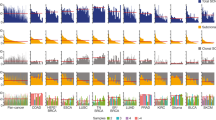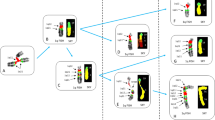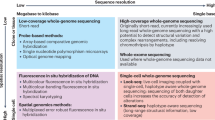Abstract
We recently showed that the 1.7 megabase multiple aberration region (MAR) on human chromosome 12q15 harbours recurrent breakpoints frequently found in a variety of benign solid tumours. We now report a candidate gene within MAR suspected to be of pathogenetical relevance. Using positional cloning, we have identified the high mobility group protein gene HMGI–C within a 175 kilobase segment of MAR and characterized its genomic organization. By FISH analysis, we show the majority of the breakpoints of eight different benign solid tumour types fall within this gene. By Southern blot and 3′–RACE analysis, we demonstrate consistent rearrangements in HMGI–C and/or expression of altered HMGI–C transcripts. These results suggest a link between a member of the HMG gene family and benign solid tumour development.
This is a preview of subscription content, access via your institution
Access options
Subscribe to this journal
Receive 12 print issues and online access
$209.00 per year
only $17.42 per issue
Buy this article
- Purchase on Springer Link
- Instant access to full article PDF
Prices may be subject to local taxes which are calculated during checkout
Similar content being viewed by others
References
Mitelman, F. Catalog of chromosome aberrations in cancer. 4th ed., New York, Wiley-Liss (1994).
Turc-Carel, C. et al. Cytogenetic studies of adipose tissue tumors. II. Recurrent reciprocal translocation t(12;16)(q13;p11) in myxoid liposarcomas. Cancer Genet. Cytogenet. 23, 291–299 (1986).
Fletcher, J.A. Translocation (12;22)(q13–14q12) is a nonrandom aberration in soft-tissue clear-cell sarcoma. Genes Chrom. Cancer 5, 184 (1992).
Roberts, P. et al. 12q13 Abnormality in rhabdomyosarcoma. A nonrandom Occurrence? Cancer Genet. Cytogenet. 60, 135–140 (1992).
Aman, P. et al. Rearrangement of the transcription factor gene CHOP in myxoid liposarcomas with t(12;16)(q13;p11). Genes Chrom. Cancer 5, 278–285 (1992).
Rabbitts, T.H., Forster, A., Larson, R. & Nathan, P. Fusion of the dominant negative transcription regulator CHOP with a novel gene FUS by translocation t(12;16) in malignant liposarcoma. Nature Genet. 4, 175–180 (1993).
Zucman, J. et al. EWS and ATF-1 gene fusion induced by t(12;22) translocation in malignant melanoma of soft parts. Nature Genet. 4, 341–345 (1993).
Van de Ven, W.J.M. et al. Molecular characterization of MAR, a multiple aberration region on human chromosome segment 12q13–q15 implicated in various solid tumors. Genes Chrom. Cancer 12, 296–303 (1995).
Cramer, D.W. Epidemiology of myomas. Semin. Repro. Endocrinol. 10, 320–324 (1992).
Schoenmakers, E.F.P.M. et al. Physical mapping of chromosome 12q breakpoints in lipoma, pleomorphic salivary gland adenoma, uterine leiomyoma, and myxoid liposarcoma. Genomics 20, 210–222 (1994).
Schoenmakers, E.F.P.M. et al. Identification, molecular cloning and characterization of the chromosome 12 breakpoint cluster region of uterine leiomyomas. Genes Chrom. Cancer 11, 106–118 (1994).
Rohen, C. et al. The 12q aberration of a breast hamartoma maps within MAR. Genes Chrom. Cancer (in the press).
Schoenmakers, E.F.P.M. et al. A 6 Mb yeast artificial chromosome contig and long range physical map encompassing the region on chromosome 12q15 frequently rearranged in a variety of benign solid tumors. Genomics (in the press).
Kools, P.F.J. et al. Identification of the chromosome 12 translocation breakpoint region of a pleomorphic salivary gland adenoma with t(1;12)(p22;q15) as the sole cytogenetic abnormality. Cancer Genet. Cytogenet. 79, 1–7 (1995).
Kievits, T. et al. Rapid subchromosomal localization of cosmids by nonradioactive in situ hybridization. Cytogenet. Cell Genet. 53, 134–136 (1990).
Smith, M.W., Holmsen, A.L., Wei, Y.H., Peterson, M. & Evans, G.A. Genomic sequence sampling: a strategy for high resolution sequence-based physical mapping of complex genomes. Nature Genetics 7, 40–47 (1994).
Altschul, S.F., Gish, W., Miller, W., Myers, E.W. & Lipman, D.J. Basic local alignment search tool. J. molec. Biol. 215, 403–410 (1990).
Patel, U.A. et al. Expression and cDNA cloning of human HMGI-C phosphoprotein. Biochem. Biophys. Res. Commun. 201, 63–70 (1994).
Bustin, M., Lehn, D.A. & Landsman, D. Structural features of the HMG chromosomal proteins and their genes. Biochim. Biophys. Acta 1049, 231–243 (1990).
Manfioletti, G. et al. cDNA cloning of the HMGI-C phosphoprotein, a nuclear protein associated with neoplastic and undifferentiated phenotypes. Nucl. Acids Res. 19, 6793–6797 (1991).
Wagner, M.J., Ge, Y., Siciliano, M. & Wells, D.E. A hybrid cell mapping panel for regional localization of probes to human chromsome 8. Genomics 10, 114–125 (1991).
Schoenberg Fejzo, M. et al. Identification of a YAC spanning the translocation breakpoints in uterine leiomyomata, pulmonary chondroid hamartoma and lipoma. Genomics 26, 265–275 (1995).
Friedman, M., Holth, L.T., Zoghbi, H.Y. & Reeves, R. Organization, inducible-expression and chromosome localization of the human HMG-I(Y) nonhistone protein gene. Nucl. Acids Res. 21, 4259–4267 (1993).
Rabbitts, T.H. Chromosomal translocations in human cancer. Nature 372, 143–149 (1994).
Yang-Yen, H.F. & Rothblum, L.I. Purification and characterization of a high-mobility-group-like DNA-binding protein that stimulates rRNA synthesis in vitro. Molec. cell. Biol. 8, 3406–3414 (1988).
Reeves, R., Langan, T.A. & Nissen, M.S. Phosphorylation of the DNA-binding domain of nonhistone high-mobility group I protein by cdc2 kinase: reduction of binding affinity. Proc. natn. Acad. Sci. U.S.A. 88, 1671–1675 (1991).
Thanos, D. & Maniatis, T. The high mobility group protein HMGI(Y) is required for NF-KB-dependent virus induction of the human IFN-β gene. Cell 71, 777–789 (1992).
Du, W. & Maniatis, T. The high mobility group protein HMGI(Y) can stimulate or inhibit DNA binding of distinct transcriptional factor ATF-2 isoforms. Proc. natn. Acad. Sci. U.S.A. 91, 11318–11322 (1994).
Aizawa, S., Nishino, H., Saito, K., Kimura, K., Shirakawa, H. & Yoshida, M. Stimulation of transcription in cultured cells by high mobility group protein 1: Essential role of the acidic carboxy-terminal region. Biochemistry 33, 14690–14695 (1994).
Miles, H., Mcfarlane, J., Aleck, K.A. & Bawle, E. Macrocephaly with hamartomas: Bannayan-Zonana syndrome. Am. J. med. Genet. 19, 225–234 (1984).
Kazmierczak, B., Bartnitzke, S., Hartl, M. & Bullerdiek, J. In vitro transformation by the SV40 “early region” of cells from a human benign salivary gland tumor with a 12q13-q15 rearrangement. Cytogenet. Cell Genet. 53, 37–39 (1990).
Albertsen, H.M., Adderrahim, H., Cann, H.M., Dausset, J., Le Paslier, D. & Cohen, D. Construction and characterization of a yeast artificial chromosome library containing seven haploid human genome equivalents. Proc. natn. Acad. Sci. U.S.A. 87, 4256–4260 (1990).
Chumakov, I. et al. Continuum of overlapping clones spanning the entire human chromosome 21 q. Nature 359, 380–387 (1992).
Green, E.D. & Olson, M.V. Systematic screening of yeast artificial-chromosome libraries using the polymerase chain reaction. Proc. natn. Acad. Sci. U.S.A. 87, 1213–1217 (1990).
Montgomery, K.T. et al. Characterization of two chromosome 12 cosmid libraries and development of STSs from cosmids mapped by FISH. Genomics 17, 682–693 (1993).
Geurts, J.M.W., Schoenmakers, E.F.P.M., Mols, R. & Van de Ven, W.J.M. Improved procedure for rapid isolation and sequencing of DNA insert termini in yeast artificial chromosomes. Meth. molec. cell. Biol. 4, 257–265 (1994).
Nelson, D.L. et al. Alu polymerase chain reaction: A method for rapid isolation of human-specific sequences from complex DNA sources. Proc. natn. Acad. Sci. U.S.A. 86, 6686–6690 (1989).
Rychlik, W. & Rhoads, R.E. A computer program for choosing optimal oligonucleotides for filter hybridization, sequencing and in vitro amplification of DNA. Nucl. Acids Res. 17, 8543–8551 (1989).
Feinberg, A.P. & Vogelstein, B. A technique for radiolabelling DNA restriction endonuclease fragments to high specific activity. Anal. Biochem. 132, 6–13 (1984).
Author information
Authors and Affiliations
Rights and permissions
About this article
Cite this article
Schoenmakers, E., Wanschura, S., Mols, R. et al. Recurrent rearrangements in the high mobility group protein gene, HMGI-C, in benign mesenchymal tumours. Nat Genet 10, 436–444 (1995). https://doi.org/10.1038/ng0895-436
Received:
Accepted:
Issue Date:
DOI: https://doi.org/10.1038/ng0895-436
This article is cited by
-
Endometrial polyps—neoplastic lesions or not? Is it time to close the files?
Modern Pathology (2022)
-
Molekulare Pathologie benigner gynäkologischer Erkrankungen – ist sie hilfreich bei zukünftigen Therapieentscheidungen?
Die Gynäkologie (2022)
-
Exosomal HMGA2 protein from EBV-positive NPC cells destroys vascular endothelial barriers and induces endothelial-to-mesenchymal transition to promote metastasis
Cancer Gene Therapy (2022)
-
CircFAM73A promotes the cancer stem cell-like properties of gastric cancer through the miR-490-3p/HMGA2 positive feedback loop and HNRNPK-mediated β-catenin stabilization
Journal of Experimental & Clinical Cancer Research (2021)
-
12q14 microduplication: a new clinical entity reciprocal to the microdeletion syndrome?
BMC Medical Genomics (2020)



